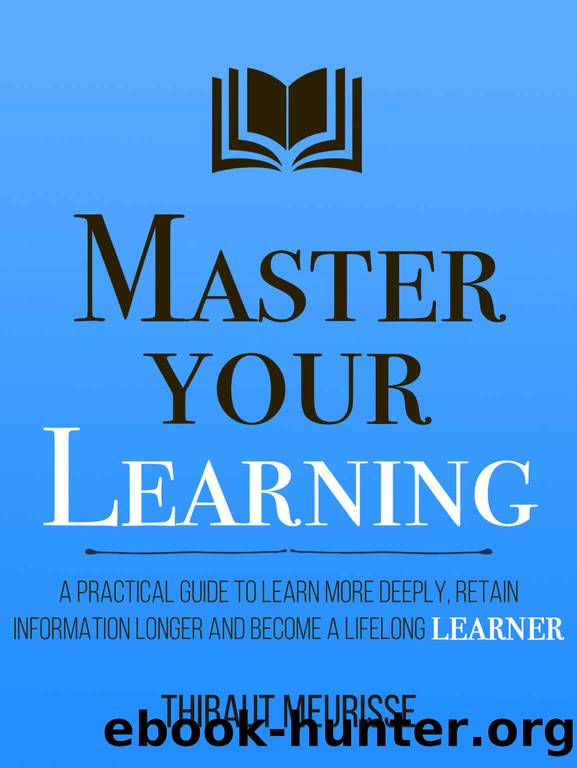Master Your Learning: A Practical Guide to Learn More Deeply, Retain Information Longer and Become a Lifelong Learner by Meurisse Thibaut

Author:Meurisse, Thibaut
Language: eng
Format: epub
Published: 2022-02-18T00:00:00+00:00
How to take notes when reading a book
You certainly donât need to take notes all the time, trying to remember every point in every book you read. However, for interesting books, you might want to spend extra time taking notes, so that you can remember them better, or refer to them later.
Letâs see what you can specifically do to help you get more out of the books you read.
Set a goal
Before you start reading any book, itâs a good idea to have a goal in mind. For instance, if you do research, you wonât approach a book the same way as when reading for pleasure. By knowing what you want to get out of a book, youâll be able to make the most of your reading.
Letâs say you are trying to find a specific piece of information. In this case, you might go through several books and only read one relevant chapter in one of these books. On the other hand, if youâre learning about a more general topic, it might make sense to read a book on that topic from cover to cover. It all depends on your goal.
Skim through the book
Whenever you start reading a book, spend a few minutes skimming through it. This will give you a better sense of what the book is about, which will also help you decide whether you want to read all of it, part of it or none of it. Understanding how the book is structured will also help retain more information.
To skim through a book:
Read the title and subtitle carefully. This is obvious, but worth mentioning. The title and subtitles (for non-fiction books) will generally tell you what the book is about and what it will cover and not cover. This will help you decide whether the book is likely to include the information you need.
Review the table of contents. Read the table of contents and try to understand what the book is about, and how it is structured. How many parts are there? Whatâs the logic? What information seems to be covered? What seems to be left out and why?
Read the introduction and conclusion. Read the introduction and try to identify the main thesis and key arguments. Then, read the conclusion and identify the main lessons and key points covered in the book.
Read summaries at the end of each chapter. Sometimes, the author lists the main takeaways at the end of each chapter. If so, go through them quickly.
Download
This site does not store any files on its server. We only index and link to content provided by other sites. Please contact the content providers to delete copyright contents if any and email us, we'll remove relevant links or contents immediately.
| ASVAB | GED |
| GRE | NCLEX |
| PRAXIS | SAT |
| See more | Flash Cards |
| Study Guides | Study Skills |
| Workbooks |
Talking to Strangers by Malcolm Gladwell(13222)
The Compound Effect by Darren Hardy(8808)
Tools of Titans by Timothy Ferriss(8218)
Wonder by R. J. Palacio(8009)
The Lover by Duras Marguerite(7830)
A Court of Wings and Ruin by Sarah J. Maas(7651)
The Circle by Dave Eggers(7035)
Deep Work by Cal Newport(6879)
Kaplan MCAT General Chemistry Review by Kaplan(6867)
To All the Boys I've Loved Before by Jenny Han(5775)
Wiseguy by Nicholas Pileggi(5671)
The Body: A Guide for Occupants by Bill Bryson(4974)
1,001 ASVAB Practice Questions For Dummies by Powers Rod(4453)
Eat That Frog! by Brian Tracy(4434)
Cracking the GRE Premium Edition with 6 Practice Tests, 2015 (Graduate School Test Preparation) by Princeton Review(4224)
Pre-Suasion: A Revolutionary Way to Influence and Persuade by Robert Cialdini(4145)
Barron's AP Biology by Goldberg M.S. Deborah T(4097)
ACT Math For Dummies by Zegarelli Mark(3994)
Alive: The Story of the Andes Survivors by Piers Paul Read(3968)
